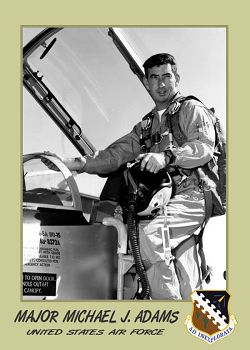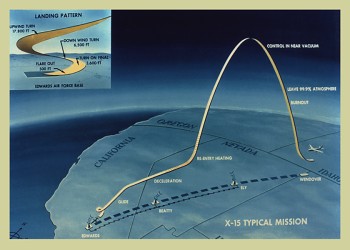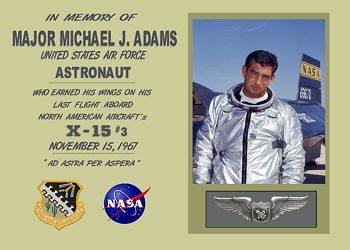
 |
Adams' last mission began with a climb to around 40,000 feet beneath the wing of a modified B-52 launch aircraft. Following release over Delamar Lake, Nev., the X-15 began its ascent. Within minutes Adams had breached the edge of space, climbing to a peak altitude of 266,000 feet (50.38 miles). During the climb-out, an electrical disturbance from an onboard experiment caused a transient motion in three control system servo-actuators, deactivating the normal reaction controls that kept the vehicle in its proper attitude while flying above the atmosphere. It also affected the inertial system and boost-guidance computers, causing erroneous data to be displayed on the instruments. An investigation later concluded that Adams was probably also suffering from vertigo. Coupled with the distraction of the malfunctioning systems, this was a deadly combination.
 |
The heading drift increased while the X-15 was traveling at a speed of Mach 5 (approximately 3,400mph) and an altitude of 230,000 feet. Finally recognizing his situation, Adams reported to ground personnel that "I'm in a spin." No pilot had ever experienced a hypersonic spin and ground control was powerless to offer advice.
Through some combination of piloting skills and the airplane's inherent stability, Adams managed to recover from the spin at 120,000 feet. He found himself in an inverted dive and the X-15 soon developed a self-sustaining pitch oscillation that saturated the flight control system. By now the X-15 was descending at a rate of about 160,000 feet per minute.
As the X-15 plunged through increasingly dense atmosphere the air loads began taking their toll on the vehicle's structure. Dynamic pressure was increasing at nearly 100 pounds per square foot each second, accompanied by rapidly increasing g-forces, and structural limitations were soon exceeded. The vehicle broke into several large pieces at an altitude of 62,000 feet while traveling nearly 4,000 mph. Adams, possibly incapacitated, did not eject. He was killed when the forward section of the rocket plane impacted the desert near Johannesburg, California. Adams was the 27th American to fly more than 50 miles above the Earth's surface and was awarded astronaut wings posthumously.
Michael J. Adams was born in Sacramento on May 5, 1930, to Michael and Georgia Adams. He enlisted in the U.S. Air Force in 1950 following graduation from Sacramento Junior College, where he was a varsity javelin thrower and baseball outfielder. After basic training at Lackland Air Force Base, Texas, he served with the 3501st Pilot Training as a Link Trainer instructor until he was selected as an Aviation Cadet. Adams underwent primary training at Spence Field, Georgia, in October 1951. From Spence he went to Webb Air Force Base, Texas, for advanced training, where he earned his pilot wings and commission on October 25, 1952.
Adams then transferred to Nellis Air Force Base, Nev., for gunnery school, where he flew the F-80 and F-86. Upon completion in April 1953, Adams was assigned to the 80th Fighter-Bomber Squadron at Suwon, South Korea. There he flew 49 combat missions and was awarded the Air Medal for meritorious achievements, accomplished with distinction above and beyond that expected of professional airmen, while participating in aerial flight operations.
Returning from Korea in February 1954, Adams spent the next two and a half years with the 813th Fighter-Bomber Squadron at England Air Force Base, La., plus six months rotational duty at Chaumont Air Base in France.
Adams then entered the University of Oklahoma at Norman, as part of an Air Force career development program for promising officers. He earned his aeronautical engineering degree in 1958 and later conducted graduate work in astronautics at the Massachusetts Institute of Technology at Cambridge. After completing these studies, Adams went to work as an instructor for the Maintenance Officer Course at Chanute Air Force Base, Ill.
During this time he was selected as a student for the Experimental Test Pilot School at Edwards. Adams graduated in 1962 and, as the outstanding pilot and scholar in his class, was awarded the Honts Trophy. He was then selected to attend the Aerospace Research Pilot School, also at Edwards, under the command of Col. Charles E. "Chuck" Yeager.
While attending the ARPS, Adams survived a landing accident in a two-seat F-104 by making a critical split-second decision. Adams was riding in the back seat of the airplane, which was piloted by fellow student Dave Scott, who would later become a Gemini and Apollo astronaut and director of NASA's Dryden Flight Research Center. As Scott was making a simulated X-15 approach for training and evaluation purposes, the F-104 suddenly lost power and began to drop rapidly. Both pilots realized that the jet would hit hard, and each made opposite decisions that saved their lives. Scott elected to stay with the airplane while Adams chose to eject. Adams pulled the ejection handle just as the F-104 slammed into the runway, breaking off its landing gear. His timing was perfect. Had he ejected before impact, his parachute would not have had time to deploy due to the rapid rate of descent. If he had delayed ejecting for even a fraction of a second, he would have been crushed when the airplane's jet engine slammed forward into the rear cockpit. Adams' parachute opened just seconds before he hit the ground. He waved to Scott who was climbing safely from the burning wreck. Scott's ejection seat had partially sequenced during the initial impact, locking his feet into the stirrups. If Scott had ejected, he would have been killed.
Adams graduated with honors from the ARPS in 1963 and was subsequently assigned to conduct stability and control tests in the Northrop F-5A jet fighter. He later served as the Air Force project pilot on the Cornell Aeronautical Laboratory variable stability T-33 program at Buffalo, NY. Adams was also one of four aerospace research pilots from Edwards to participate in a five-month series of NASA moon landing practice tests, beginning in January 1964, at the Martin Company in Baltimore, Md. The tests involved simulated lunar landing missions in a full-scale command module and lunar excursion module crew compartment mock-up. Four seven-day simulated lunar landing missions were conducted, each with a three-man crew.
In October 1965, Adams was selected as an astronaut candidate for the Air Force Manned Orbiting Laboratory. An early space station design, the MOL (also known as KH-10) was designed to serve as a space-based reconnaissance platform. With the advent of the Corona (KH-4) unmanned reconnaissance satellite program, Adams realized that there was little chance of a MOL flight in his future, and he requested transfer to the X-15 program. In July 1966 he was accepted as the 12th and final X-15 pilot.
During his first X-15 flight on October 6, 1966, Adams achieved a speed of Mach 3, but a ruptured fuel tank caused premature engine shutdown 90 seconds after launch from beneath the wing of the B-52. Adams was forced to make an emergency landing at Cuddeback Dry Lake, about 40 miles northwest of Edwards. While on final approach to the lakebed, Adams remarked, "This thing is sort of fun to fly!" Ironically, Adams had a second emergency that day. During a routine proficiency flight in a T-38, he suffered an engine failure and had to make an emergency landing at Edwards.
Adams made his second X-15 flight with only minor technical difficulties and exceeded Mach 4, achieving a speed of 3,120 mph.
During his third flight, on March 2, 1967, he lost cabin pressure while climbing through 77,000 feet, causing his pressure suit to inflate. While this made it more difficult for Adams to fly the airplane, it was only the beginning of his troubles. As Adams arced the X-15 through a peak altitude of 133,000 feet and a maximum speed of Mach 5.59 (3,822 mph) his inertial computer failed, causing a loss of all velocity, altitude and climb-rate readouts. Even without this data Adams made a successful reentry and return to Edwards. On approach he radioed ground controller and fellow X-15 pilot Maj. William J. "Pete" Knight, saying "I thought you said every once in a while something goes wrong, Pete." In a post-flight debriefing Adams revealed that he had suffered vertigo during the climb-out. This problem would return to haunt him again.
During his fourth and fifth flights, Adams encountered minor glitches but nothing unusual. On his sixth flight, the engine failed to ignite. Adams went through the restart procedure twice, finally igniting the rocket 16 seconds after launch. The rest of the flight was fairly uneventful. His seventh and final flight ended in tragedy, cutting short a stellar career. At the time of his death, Adams had logged 4,574 flight hours. He had flown a wide variety of airplanes that included the T-6, F-80, F-84F, F-86, F-101, F-104, F-106, F-5, YAT-28, T-33 and T-38.
 |
